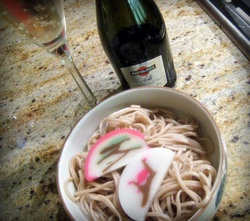Born in Hawaii and raised by Nisei parents, I grew up with a mixed plate of influences. My mother is Episcopalian, but her Issei parents were Buddhist. My Issei paternal grandfather was Catholic. My father, if anything, respects the traditions of the Hawaiians. Preparing for New Year’s is one of the clearest examples of how Japanese, Hawaii-Japanese, American and many other traditions and foods melded into a unique, yet shared Nikkei experience that continues to evolve as the community does.
Christmas Day meant going to the Episcopalian church to celebrate the birth of Jesus, presents, and the start of thank-you note writing. But for my grandmother, it was the unequivocal signal to Begin Preparing for New Year’s. Japanese tradition dictated that your entire home must be thoroughly and fanatically cleaned before New Year’s Day, January 1st. This went far beyond routine cleaning. It meant dusting baseboards, trips to Goodwill, culling toys, rotating mattresses, cleaning up longstanding scuff marks, usually with a toothbrush, and vacuuming places that no one ever saw except for when cleaning for New Year's.
Small children like me were assigned low-height tasks such as brushing out cobwebs and dried insects lodged in sliding glass door tracks and wiping red dirt from the infinite number of glass jalousies in Hawaii homes. Even if you had the luxury of having a housekeeper, New Year’s cleaning was something for You to do. The process of cleaning was just as important as the result.
By New Year’s Eve, you must have taken out all the trash, done your laundry, brushed your teeth, taken a bath and changed into clean and preferably new clothes, which you likely received for Christmas in the previous week. This is supposed to get rid of the all the old, bad and unclean spirits in the house and literally start the year clean. We were declared ready to greet the New Year, armed with new omamori, kagami mochi on the cars and the dining table, and a fresh set of St. Timothy offering envelopes. We had paid our respects to God, Buddha, our ancestors and the spirit world.
Finally the fun and food started. It was a casual Hawaii/Japanese/American tailgate-style party, but at home. Aunties and Uncles had trademark dishes that they brought every year. As a child, I was always on the lookout for the arrival of my favorite Chinese chicken salad and not necessarily the Aunty who made it.
The table was a riot of fine Japanese Imari serving platters, Tupperware and recycled takeout containers. There was snack food: ogo, inari , warabi, smoked tako, kaki mochi, and potato chips with clam dip. Main dishes meant sushi, fried noodles, manapua, the pidgin term for char siu bao, grilled meat, hot dogs, musubi, kim chee, macaroni/potato salad, my beloved Chinese chicken salad, pipi kaula, poke, and sashimi bought, or more likely, caught specifically for New Year’s. Desserts always included mochi, some form of Jello- or CoolWhip-based dessert as well as yokan. We ate on paper plates, usually in a relative’s garage, with various friends and family dropping in and adding to the food table.
Uncles drank beer, smoked non-stop because they could back then, talked about bowl games, and pretended to supervise the kids’ firecracker activities. Burning firecrackers and sparklers on New Year’s Eve symbolically drives out evil, unclean spirits. But for a kid, it was just plain fun, especially since it was a little dangerous. The big firecrackers, long threads of rolled red paper went off at midnight. By 12:15 am, the streets would be dry-flooded with red paper firecracker detritus and the grey smell of gunpowder simply sat in that humid Hawaii air. To this day, the smell of gunpowder is a happy reminder of my childhood.
Once the fireworks were done, we all watched Dick Clark, ate New Year’s kamboko with our soba, a symbol for long life and prosperity, and sipped champagne or Martinelli’s sparkling apple cider. Literally the first thing done in the New Year was together with your family, in your home, and in the hope for a year of good fortune.
I still clean like a madwoman for New Year’s, but the Sansei definition of “New Year’s Day” has been extended to the late-January Lunar New Year. In addition, I’ve adopted a New Year’s Day morning run and a cyber-purge of email and computer files. My children used to think this weird, manic phase only afflicted their mother, but they have come to accept this as a “weird family Japanese thing,” especially once they realized that all their other Nikkei friends and relatives are similarly crazed during this time. Spring cleaning is a foreign concept to my children.
As an adult living in the big world on the Mainland, my husband and I once spent New Year’s Eve in San Francisco at a swanky New Year’s Eve bash. It was lovely. But it just didn’t feel right. I realize now that I would never spend New Year’s in Times Square. It’s not that it wouldn’t be fun—but on New Year’s, the right and happiest place for me is at home and with my family.
My Yonsei-and-half teenage children now receive invitations to various New Year’s Eve parties. While they know that they are expected to be home, it is deeply satisfying that they want to be home. More importantly, they’ve made New Year’s their own. They invite their friends, all very much not Nikkei, to snack all night, play video games, burn sparklers, and still share soba, kamaboko, and champagne/apple cider with us.
Garage parties and the smell of gunpowder are my memories. My teenagers have forged their own by planning their December Chinatown excursion for sparklers, opting for the indestructible plastic kagami mochi, thinking about which friends will join them, and what food they will bring. New Year’s adapts and endures.
© 2012 Laurie Iwami





